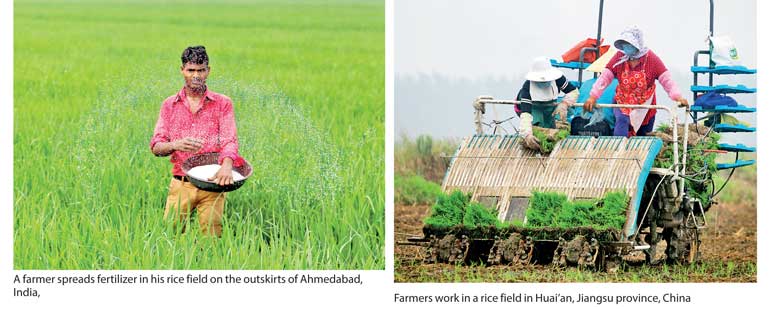Tuesday Apr 22, 2025
Tuesday Apr 22, 2025
Friday, 26 January 2018 00:00 - - {{hitsCtrl.values.hits}}
 Kuala Lumpur (Thomson Reuters Foundation): Representatives of a pilot project that promotes socially and environmentally responsible rice growing said they aim to expand into India and China, the world’s largest rice producers.
Kuala Lumpur (Thomson Reuters Foundation): Representatives of a pilot project that promotes socially and environmentally responsible rice growing said they aim to expand into India and China, the world’s largest rice producers.
The United Nations Environment Program (UNEP) and the Philippines-based International Rice Research Institute (IRRI) worked with more than 80 partners to create the world’s first “global rice sustainability standard”.
The standard provides a framework to drive government policy, as well as a working definition to be used by the private sector to monitor their own sustainability goals.
The sustainability standard has been tested over the past two years in nine countries, mostly in Southeast and South Asia.
“This is a fledgling project still - our next task will be to upscale,” said Wyn Ellis, coordinator for the Sustainable Rice Platform (SRP).
The SRP is a coalition of more than 80 representatives from non-governmental organisations, and the private and public sectors, which launched the sustainability standard in 2015.
“We will need to be moving into China and into India quite soon - those are our priorities in future,” he told the Thomson Reuters Foundation.
The standard promotes improvements in rice farming using more than 40 requirements and “performance indicators”, which authorities and companies such traders and supermarkets can use as best practice guidance.
These include measures against abuses such as child labour. The standard also aims to make rice growing more environmentally friendly by, for example, restricting the use of pesticides.
Members of the SRP hope that the standard will also be used in a certification scheme to help consumers choose ethical rice. Governments may also use it to promote sustainable rice farming and meet emissions targets.
Water management is crucial factor in achieving those targets.
Up to 40% of the world’s irrigation water is used for rice production, while up to 10% of global methane emissions come from rice fields, according to the SRP.
During pilot testing, the standards helped reduced the water used in rice farming by 20%, cut greenhouse gas emissions by 50% and increased farmers’ incomes by 10%.
“It is huge,” said Bruce Tolentino, deputy director general at IRRI, referring to the sustainability standard, which he hoped could be expanded globally.
The world produced more than 500 million tonnes of milled rice in 2017, with China, India, Indonesia, Bangladesh, Vietnam and Thailand among the top growers.
The grain is the main staple for 3.5 billion people but as the world’s population continues to grow, output will need to rise by about 25% over the next quarter century, IRRI estimates.
Discover Kapruka, the leading online shopping platform in Sri Lanka, where you can conveniently send Gifts and Flowers to your loved ones for any event including Valentine ’s Day. Explore a wide range of popular Shopping Categories on Kapruka, including Toys, Groceries, Electronics, Birthday Cakes, Fruits, Chocolates, Flower Bouquets, Clothing, Watches, Lingerie, Gift Sets and Jewellery. Also if you’re interested in selling with Kapruka, Partner Central by Kapruka is the best solution to start with. Moreover, through Kapruka Global Shop, you can also enjoy the convenience of purchasing products from renowned platforms like Amazon and eBay and have them delivered to Sri Lanka.
Discover Kapruka, the leading online shopping platform in Sri Lanka, where you can conveniently send Gifts and Flowers to your loved ones for any event including Valentine ’s Day. Explore a wide range of popular Shopping Categories on Kapruka, including Toys, Groceries, Electronics, Birthday Cakes, Fruits, Chocolates, Flower Bouquets, Clothing, Watches, Lingerie, Gift Sets and Jewellery. Also if you’re interested in selling with Kapruka, Partner Central by Kapruka is the best solution to start with. Moreover, through Kapruka Global Shop, you can also enjoy the convenience of purchasing products from renowned platforms like Amazon and eBay and have them delivered to Sri Lanka.